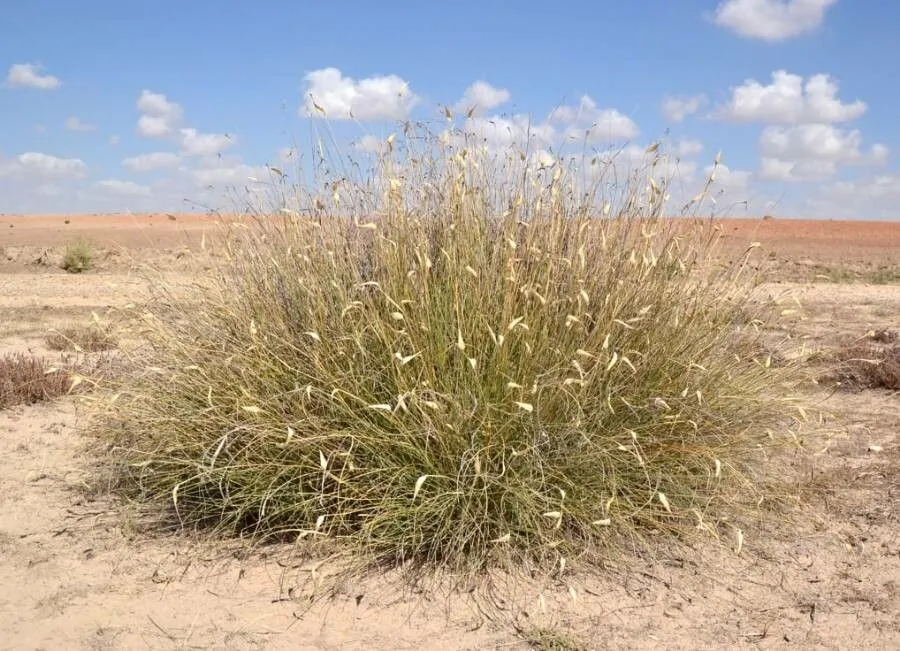
Author: Loefl. ex L.
Bibliography: Gen. Pl. ed. 5: 522 (1754)
Year: 1754
Status: accepted
Rank: species
Genus: Lygeum
Vegetable: False
Observations: Medit.
Albardine, scientifically known as Lygeum spartum, is a remarkable plant species prevalent in the Mediterranean region. Introduced in the mid-18th century bibliography “Gen. Pl. ed. 5: 522 (1754)” by its author Loefl. ex L., this plant belongs to the Poaceae family, commonly referred to as the grasses.
Adapted to the unique Mediterranean climate, Albardine demonstrates resilience in a variety of environments, often flourishing in arid, sandy soils where other vegetation struggles to survive. Its structure is well-adapted to withstand dry conditions, featuring rigid, narrow leaves that help reduce water loss. These leaves often grow in dense, tuft-like clusters, which provide an efficient mechanism for retaining moisture and reducing soil erosion.
Albardine has been long valued not just for its ecological benefits but also for its utilitarian purposes. Historically, the fibrous nature of Albardine’s leaves has made it an excellent material for weaving and basket-making, a practice that has been prevalent in Mediterranean cultures for centuries. Its strong, flexible fibers are used to create a variety of practical goods, showcasing the plant’s versatility.
In terms of its ecological role, Albardine contributes significantly to soil stabilization and the prevention of desertification, making it a crucial plant for maintaining the health of ecosystems in its native range. It also serves as a habitat for various microfauna, promoting biodiversity in the regions it inhabits.
Understanding the role of Lygeum spartum in its native habitat provides valuable insights into the adaptation strategies of plants in Mediterranean climates and highlights its importance from both an ecological and cultural perspective.
Eng: albardine
En: Albardine, Lygeum
Ar: حلفا، حلفاء
Fi: Espartoheinä
He: חלפה רותמית
It: Alfa, Sparto steppico
Es: Albardín
Taken May 21, 2021 by Encinas Juan (cc-by-sa)
Taken Apr 28, 2022 by Giulia Perra (cc-by-sa)
Taken Jul 11, 2020 by Pedro Gaspar (cc-by-sa)
Taken Jul 1, 2020 by Diego Alex (cc-by-sa)
Taken Jul 11, 2020 by Pedro Gaspar (cc-by-sa)
Taken Feb 9, 2020 by Diego Alex (cc-by-sa)
Taken Dec 31, 2019 by Diego Alex (cc-by-sa)
Taken Jun 16, 2021 by agrowlice (cc-by-sa)
Taken Jan 9, 2022 by xiomara-botanica (cc-by-sa)
Taken Jun 4, 2022 by Antonio Garcia (cc-by-sa)
Taken Jun 16, 2021 by agrowlice (cc-by-sa)
Taken Nov 9, 2020 by Sáenz Rebeca (cc-by-sa)
Taken Aug 7, 2020 by Sáenz Rebeca (cc-by-sa)
Taken Jan 17, 2022 by akicm (cc-by-sa)
Taken Aug 21, 2022 by Damyan Lesidrenski (cc-by-sa)
Taken Apr 15, 2022 by Aguilera Eduardo (cc-by-sa)
© copyright of the Board of Trustees of the Royal Botanic Gardens, Kew.
Growth habit>: Graminoid
Family: Myrtaceae Author: (F.Muell.) K.D.Hill & L.A.S.Johnson Bibliography: Telopea 6: 402 (1995) Year: 1995 Status:…
Family: Rubiaceae Author: Pierre ex A.Froehner Bibliography: Notizbl. Bot. Gart. Berlin-Dahlem 1: 237 (1897) Year:…
Family: Sapindaceae Author: Koidz. Bibliography: J. Coll. Sci. Imp. Univ. Tokyo 32(1): 38 (1911) Year:…
Family: Asteraceae Author: A.Gray Bibliography: Pacif. Railr. Rep.: 107 (1857) Year: 1857 Status: accepted Rank:…
Family: Fabaceae Author: Medik. Bibliography: Vorles. Churpfälz. Phys.-Ökon. Ges. 2: 398 (1787) Year: 1787 Status:…
Family: Aspleniaceae Author: (Cav.) Alston Bibliography: Bull. Misc. Inform. Kew 1932: 309 (1932) Year: 1932…